Neurointerventional Devices Market Size and Share
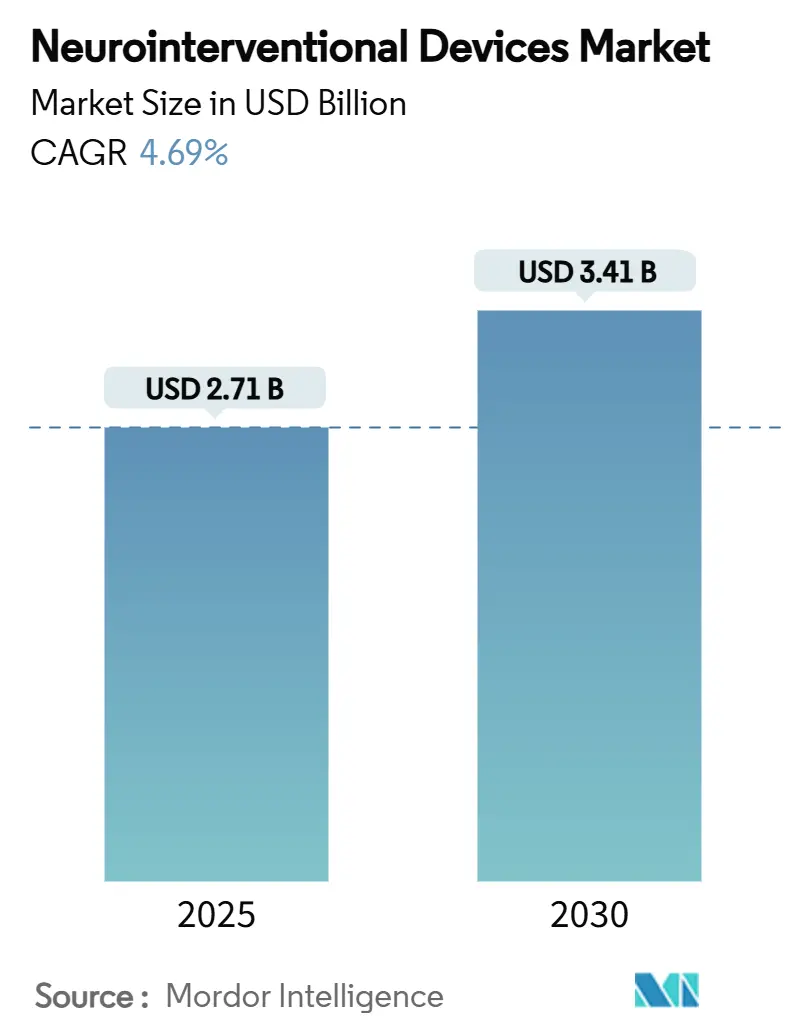
Neurointerventional Devices Market Analysis by Mordor Intelligence
The neurointerventional devices market size stands at USD 2.71 billion in 2025 and is projected to reach USD 3.41 billion by 2030, reflecting a CAGR of 4.69%. Growing preference for minimally invasive endovascular approaches, rising global stroke incidence, and continuous device innovation sustain demand. The neurointerventional devices market also benefits from the wider availability of advanced imaging and artificial intelligence tools that improve procedural planning and speed. Expansion of mechanical thrombectomy indications, combined with favorable reimbursement revisions in several countries, opens new patient pools. Meanwhile, shifting care toward outpatient settings places cost-effective devices in a strong position across the neurointerventional devices market.
Key Report Takeaways
- By product category, aneurysm coiling and embolization devices led with 38.21% revenue share in 2024, while mechanical thrombectomy is advancing at a 6.73% CAGR through 2030.
- By application, ischemic stroke accounted for 50.43% of neurointerventional devices market share in 2024 and is expanding at a 7.21% CAGR to 2030.
- By end-user, tertiary hospitals captured 71.23% share of the neurointerventional devices market size in 2024, yet ambulatory centers are growing fastest at 7.54% CAGR.
- By geography, North America held 40.64% share in 2024, whereas Asia-Pacific is projected to grow at 5.45% CAGR between 2025 and 2030.
Global Neurointerventional Devices Market Trends and Insights
Driver Impact Analysis
| Driver | % Impact on CAGR Forecast | Geographic Relevance | Impact Timeline |
|---|---|---|---|
| Rising incidence of stroke and cerebral aneurysm | +1.2% | Global, strongest in aging regions of North America, Europe, Asia-Pacific | Long term (≥ 4 years) |
| Continuous technological innovations in neurovascular devices | +1.1% | Global, led by North America and Europe innovation hubs | Medium term (2-4 years) |
| Expanding reimbursement coverage for endovascular procedures | +0.8% | North America and Europe; emerging momentum in Asia-Pacific | Medium term (2-4 years) |
| Growing acceptance of mechanical thrombectomy as standard of care | +0.9% | Global, rapid uptake in developed markets | Short term (≤ 2 years) |
| Penetration of neurointerventional suites in secondary hospitals | +0.6% | Emerging and rural settings in North America, Europe, Asia-Pacific | Short term (≤ 2 years) |
| Integration of robotics and artificial intelligence for precision navigation | +0.7% | Global, early adoption in high-income countries | Medium term (2-4 years) |
| Source: Mordor Intelligence | |||
Rising Incidence of Stroke and Cerebral Aneurysm
Stroke remained the second leading global cause of death in 2019, affecting 12.2 million people annually. Aging demographics in developed economies and climbing hypertension and diabetes prevalence in emerging regions intensify demand for neurovascular solutions. Mechanical thrombectomy volumes nearly tripled between 2017 and 2019 after treatment time windows expanded, underscoring the clinical shift toward endovascular therapy. Middle meningeal artery embolization procedures climbed from 4,014 in 2019 to 20,836 in 2023 with forecasts of 79,483 by 2029, proving sustained procedure growth[1]Journal of NeuroInterventional Surgery, “Worldwide Mechanical Thrombectomy Trends,” jnis.bmj.com. Wider adoption of minimally invasive approaches lowers overall hospital stays and costs, cementing long-term demand for the neurointerventional devices market.
Continuous Technological Innovations in Neurovascular Devices
Rapid engineering cycles introduce tools that lift success rates and broaden eligibility. Milli-spinner thrombectomy technology reaches clot-removal success above 90%, doubling traditional performance by densifying fibrin networks[2]Stanford News, “Milli-Spinner Technology Improves Clot Removal,” news.stanford.edu. AI-guided cerebral aneurysm coiling demonstrated 92.7% precision and 97.2% recall in first-in-human trials. Fourth-generation flow diverters such as Pipeline Vantage achieved 81.7% occlusion at six months with flawless deployment, while robotic systems like CorPath GRX delivered 94% procedural effectiveness across 117 embolization patients. These breakthroughs fuel competitive differentiation and uplift the neurointerventional devices market.
Growing Acceptance of Mechanical Thrombectomy as Standard of Care
Landmark trials SELECT2, ANGEL-ASPECT, and TENSION reported functional independence of 20-30% versus 7-12% for medical management, solidifying thrombectomy guidelines worldwide[3]American Heart Association, “SELECT2, ANGEL-ASPECT, and TENSION Trial Results,” strokeaha.org. Treatment windows now extend to 24 hours, increasing the eligible patient base and spurring near-threefold procedural growth after 2018. Nationwide registries like EXCELLENT logged 94.5% final recanalization in nearly 1,000 patients, validating real-world outcomes. Standardized protocols and wider training accelerate diffusion beyond comprehensive stroke centers, enlarging the neurointerventional devices market.
Integration of Robotics and Artificial Intelligence for Precision Navigation
Robotic diagnostic cerebral angiography completed 77.9% of 113 cases without manual conversion and limited mean fluoroscopy time to 13.2 minutes. AI-powered navigation platforms alert clinicians to micro-movements during aneurysm coiling, while predictive models outperform clinicians in detecting large-vessel occlusions. These tools help compensate for specialist shortages and deliver standardized high-quality care. Growing adoption of robotics and AI therefore strengthens the long-term outlook for the neurointerventional devices market.
Restraints Impact Analysis
| Restraints Impact Analysis | (~) % Impact on CAGR Forecast | Geographic Relevance | Impact Timeline |
|---|---|---|---|
| Stringent multiregional regulatory approval processes | -0.7% | Global, variable across FDA, CE Mark, NMPA | Long term (≥ 4 years) |
| Limited availability of skilled neurointerventional specialists | -0.5% | Global, most acute in emerging markets and rural areas | Long term (≥ 4 years) |
| High capital and procedure costs in resource-constrained settings | -0.6% | Low- and middle-income countries; community hospitals worldwide | Medium term (2-4 years) |
| Volatility in platinum and cobalt supply chains affecting device pricing | -0.3% | Global, with supply shocks impacting manufacturing hubs | Short term (≤ 2 years) |
| Source: Mordor Intelligence | |||
Stringent Multiregional Regulatory Approval Processes
Differing FDA, European, and NMPA requirements elongate time-to-market and inflate development costs. The EU Medical Device Regulation adds extra post-market obligations, while the FDA’s neuroendovascular surveillance mandates remain uneven. China’s updated Class III device rules require domestic clinical data and comprehensive quality systems, limiting acceptance of overseas trials. Novel AI-enabled and robotic devices face evolving frameworks that remain under development, delaying broad commercialization and tempering progress in the neurointerventional devices market.
Limited Availability of Skilled Neurointerventional Specialists
Training pathways produce relatively few specialists each year compared with growing demand. Rural areas and emerging economies struggle most with access. Medicare covers only 18-22% of thrombectomy costs, discouraging hospital investment in programs that attract and retain professionals. Multidisciplinary team requirements further constrain expansion in underserved settings, placing structural limits on near-term growth for the neurointerventional devices market.
Segment Analysis
By Product: Mechanical Thrombectomy Drives Innovation
Aneurysm coiling and embolization devices sustained leadership with 38.21% share in 2024. Flow-diverter stents such as Pipeline Vantage reached 81.7% six-month occlusion while liquid embolics like Artisse recorded 96.6% implantation success. Mechanical thrombectomy, though smaller, is the fastest rising category at 6.73% CAGR. The neurointerventional devices market size for mechanical thrombectomy is projected to expand sharply as milli-spinner systems exceed 90% removal success on fibrin-rich clots. FreeClimb 88 aspiration catheters delivered 67.9% first-pass recanalization without complications, reinforcing clinician confidence. Expanded indications into large infarcts and distal occlusions broaden its addressable base, lifting the neurointerventional devices market.
Competitive traction continues as manufacturers bundle next-generation catheters with AI-guided imaging. Such integrated solutions drive premium adoption because they shorten procedure times and lower complication rates. Clinical evidence supporting mechanical thrombectomy across previously excluded populations encourages procurement committees to allocate higher budgets, thereby sustaining the neurointerventional devices market share of this product class.
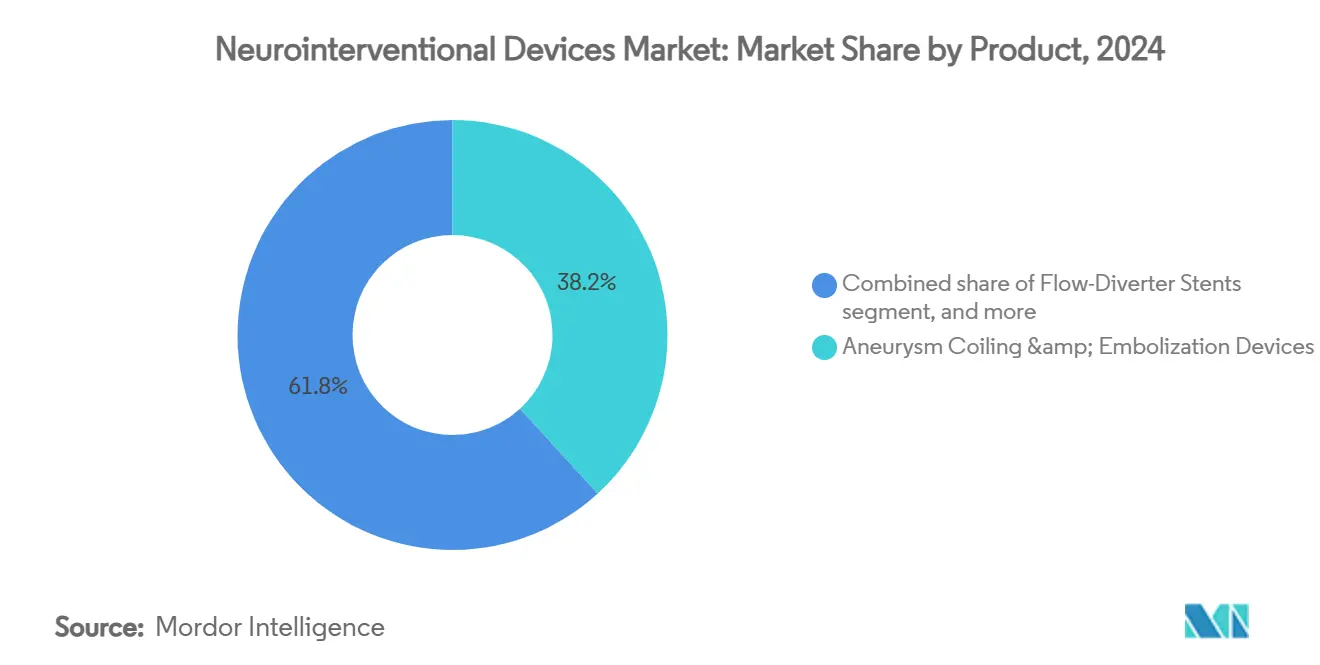
Note: Segment shares of all individual segments available upon report purchase
By Application: Ischemic Stroke Dominance Accelerates
Ischemic stroke represented 50.43% of 2024 revenue and leads growth at 7.21% CAGR. High prevalence explains volume strength, while endovascular therapy’s proven superiority over medical management fuels value. Tenecteplase approval brings a faster thrombolytic option that pairs well with thrombectomy workflows. Flow diverters and intrasaccular devices widen cerebral aneurysm care, yet stroke keeps commanding the neurointerventional devices market size due to sheer caseload.
Emerging applications in medium vessel occlusions will further energize future sales. Early evidence in distal territories encourages specialized catheter design. Meanwhile, arteriovenous malformation treatments benefit from radiopaque liquid embolics reaching 99% effectiveness. Collectively these advances secure ischemic stroke’s status as the principal revenue pillar of the neurointerventional devices market.
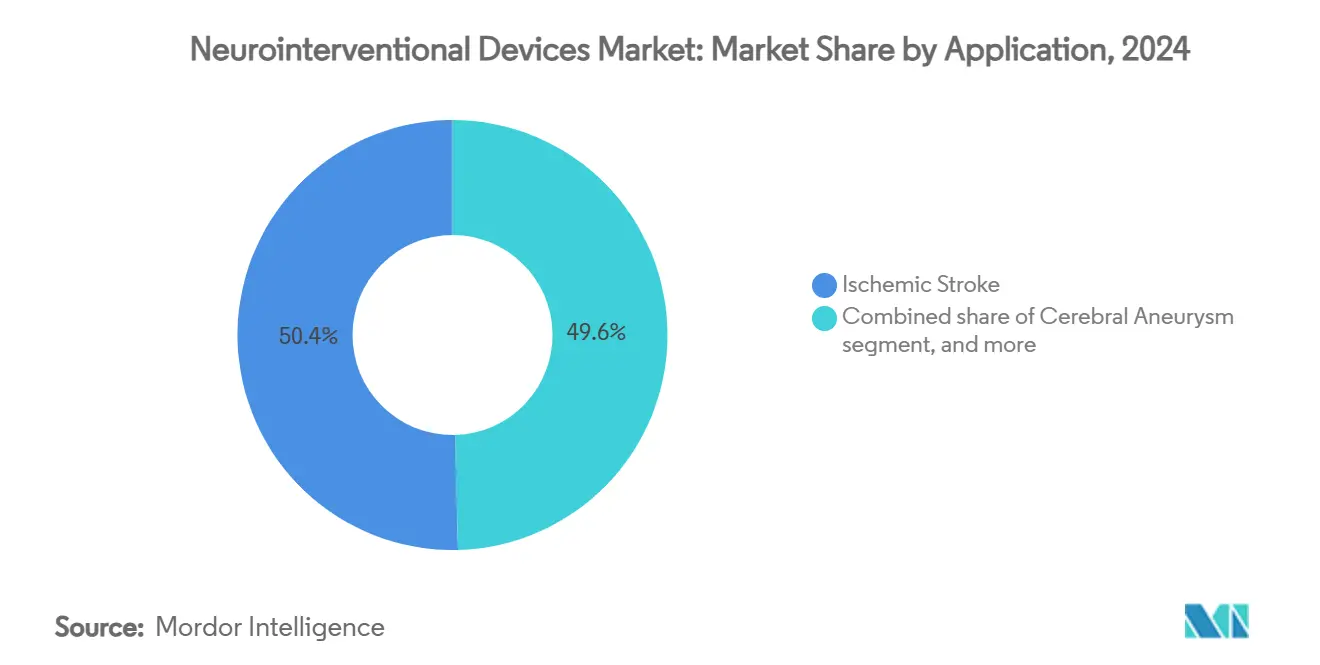
Note: Segment shares of all individual segments available upon report purchase
By End User: Ambulatory Centers Gain Momentum
Tertiary hospitals captured 71.23% share in 2024 through comprehensive stroke centers and 24-hour capability. Specialized neuroscience institutes add niche demand supported by advanced imaging. However, ambulatory surgical and cath-lab centers show the highest 7.54% CAGR as outpatient models gain payer support and device profiles slim down. Supply-cost bundling in stroke care delivers average savings of USD 2,900.93 per case, a compelling economic lever for payers.
Medicare coverage expansion for carotid stenting raises outpatient volumes, although reimbursement gaps persist. Manufacturers respond by designing low-profile systems compatible with standard cath-lab infrastructure, enabling more procedures outside tertiary settings and broadening the neurointerventional devices market.
Geography Analysis
North America held 40.64% of revenue in 2024 owing to advanced infrastructure, abundant clinical trials, and early product launches. FDA clearances for Terumo Neuro’s dual-layer carotid stent and Crossroads’ balloon guide catheter refreshed growth pipelines. The region faces pressure from Medicare undervaluations that cover just one fifth of thrombectomy cost, challenging hospital economics. Strategic acquisitions such as Stryker buying Inari for USD 4.9 billion add breadth to portfolios, keeping the neurointerventional devices market competitive.
Asia-Pacific is the fastest growing at 5.45% CAGR. China’s NMPA approved 12,213 medical device applications in 2023, a 25.4% rise that signals regulatory openness. Broader insurance and capacity investments boost procedure penetration, though skill shortages and country-specific rules persist. Japan’s structured surveillance for flow diverters emphasizes safety and fosters confidence. Collectively, modernization and demographic aging drive strong upside for the neurointerventional devices market in the region.
Europe shows steady advancement supported by Medical Device Regulation alignment and strong clinical research. Market players introduced Cerenovus’s CEREGLIDE 71 and Penumbra’s neuro access suite, underscoring ongoing innovation. Still, reimbursement varies across member states, leading companies to sequence launches strategically. Strength of value-based care programs underscores the importance of long-term outcome data for sustaining neurointerventional devices market penetration.
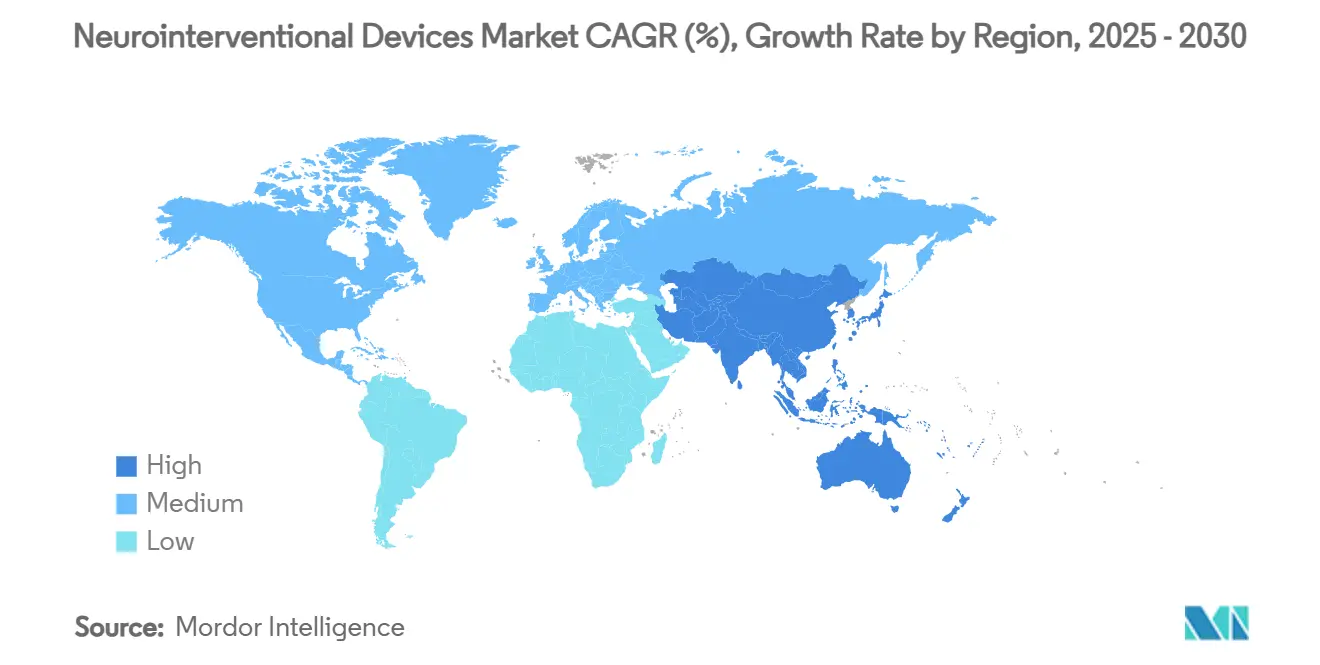
Competitive Landscape
The neurointerventional devices market exhibits moderate consolidation as top firms pursue technology differentiation and acquisition. Medtronic, Stryker, Johnson & Johnson, and Penumbra anchor global portfolios. Stryker’s USD 4.9 billion acquisition of Inari broadens thrombectomy into peripheral vascular, creating synergy with its neuro lines. Johnson & Johnson’s exploration to sell Cerenovus for about USD 1 billion may unlock opportunity for agile entrants.
Start-ups like Imperative Care and Route 92 target mechanical thrombectomy with focused innovation. FDA clearances for Crossroads Neurovascular, Perfuze, and CereVasc add fresh competition and expand treatment niches. Technology races center on AI integration, robotics, and advanced materials that improve deliverability and occlusion rates, sustaining high R&D intensity within the neurointerventional devices market.
Regional consolidation pairs with portfolio pruning as firms prioritize high-margin segments. Those with comprehensive vascular platforms, from brain to peripheral, leverage cross-selling and hospital contracting power. This dynamic sustains healthy rivalry yet presents high entry barriers, shaping the neurointerventional devices market’s medium-term trajectory.
Neurointerventional Devices Industry Leaders
-
Stryker
-
Penumbra, Inc.
-
Medtronic
-
Abbott
-
Johnson & Johnson (Cerenovus)
- *Disclaimer: Major Players sorted in no particular order
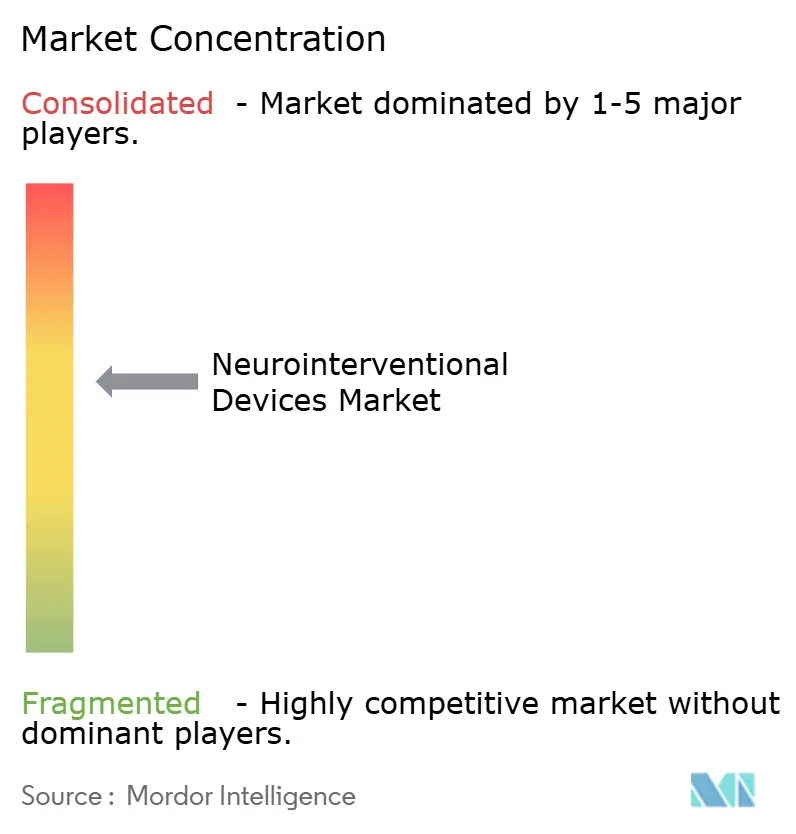
Recent Industry Developments
- June 2025: Stryker completed its USD 4.9 billion acquisition of Inari Medical, enhancing its thrombectomy portfolio.
- April 2025: Terumo Neuro gained FDA approval for its dual-layer micromesh carotid stent system.
- March 2025: The FDA approved tenecteplase for acute ischemic stroke, the first new stroke thrombolytic in three decades.
- February 2025: MicroVention rebranded as Terumo Neuro to emphasize neurovascular focus.
- February 2025: Johnson & Johnson initiated a sale process for its Cerenovus stroke business, with estimates of up to USD 1.5 billion.
- January 2025: Endovascular Engineering secured FDA IDE approval for its pivotal Helo thrombectomy trial.
Global Neurointerventional Devices Market Report Scope
As per the scope of the report, neurointerventional devices are primarily linked to the treatment of diseases with vascular diseases in the central nervous system. The Neurointerventional Devices Market is Segmented by Product (Aneurysm Coiling & Embolization Devices, Cerebral Balloon Angioplasty & Stenting Systems, Neurothrombectomy Devices, and Other Devices), Application (Ischemic Stroke, Cerebral Aneurysms, Arteriovenous Malformation & Fistulas, and Other Diseases), and Geography (North America, Europe, Asia Pacific, Middle East & Africa, and South America). The market report also covers the estimated market sizes and trends of 17 countries across major regions globally. The report offers the value (in USD million) for the above segments.
| Aneurysm Coiling & Embolization Devices |
| Flow-Diverter Stents |
| Cerebral Balloon Angioplasty & Stenting Systems |
| Mechanical Thrombectomy Devices |
| Liquid Embolics & Intrasaccular Implants |
| Ischemic Stroke |
| Cerebral Aneurysm |
| Arteriovenous Malformations/Fistulas |
| Intracerebral Hemorrhage |
| Tertiary Care Hospitals |
| Specialized Neuroscience Centers |
| Ambulatory Surgical & Cath-Lab Centers |
| North America | United States |
| Canada | |
| Mexico | |
| Europe | Germany |
| United Kingdom | |
| France | |
| Italy | |
| Spain | |
| Rest of Europe | |
| Asia-Pacific | China |
| Japan | |
| India | |
| Australia | |
| South Korea | |
| Rest of Asia-Pacific | |
| Middle East & Africa | GCC |
| South Africa | |
| Rest of Middle East & Africa | |
| South America | Brazil |
| Argentina | |
| Rest of South America |
| By Product | Aneurysm Coiling & Embolization Devices | |
| Flow-Diverter Stents | ||
| Cerebral Balloon Angioplasty & Stenting Systems | ||
| Mechanical Thrombectomy Devices | ||
| Liquid Embolics & Intrasaccular Implants | ||
| By Application | Ischemic Stroke | |
| Cerebral Aneurysm | ||
| Arteriovenous Malformations/Fistulas | ||
| Intracerebral Hemorrhage | ||
| By End User | Tertiary Care Hospitals | |
| Specialized Neuroscience Centers | ||
| Ambulatory Surgical & Cath-Lab Centers | ||
| Geography | North America | United States |
| Canada | ||
| Mexico | ||
| Europe | Germany | |
| United Kingdom | ||
| France | ||
| Italy | ||
| Spain | ||
| Rest of Europe | ||
| Asia-Pacific | China | |
| Japan | ||
| India | ||
| Australia | ||
| South Korea | ||
| Rest of Asia-Pacific | ||
| Middle East & Africa | GCC | |
| South Africa | ||
| Rest of Middle East & Africa | ||
| South America | Brazil | |
| Argentina | ||
| Rest of South America | ||
Key Questions Answered in the Report
Which products dominate global sales of neurointerventional devices?
Aneurysm coiling and embolization devices led with 38.21% share in 2024, reflecting mature clinical acceptance.
How fast is mechanical thrombectomy growing?
Mechanical thrombectomy revenue is rising at a 6.73% CAGR from 2025-2030, making it the fastest-advancing product class.
What region expands the market most rapidly?
Asia-Pacific is the quickest-growing geography with a 5.45% CAGR, encouraged by regulatory reforms and broader healthcare access.
Where do most procedures take place today?
Tertiary care hospitals performed 71.23% of interventions in 2024 due to comprehensive stroke capabilities.
What are the key restraints limiting growth?
Prolonged multiregional regulatory approval timelines and a global shortage of trained neurointerventionalists temper expansion.
Which recent FDA approval is most significant?
Tenecteplase approval in March 2025 offers the first new thrombolytic option for acute ischemic stroke in 30 years, streamlining workflows.
What is the current global market size for neurointerventional devices?
The market is valued at USD 2.71 billion in 2025 and is projected to reach USD 3.41 billion by 2030.
Page last updated on:
.webp)


